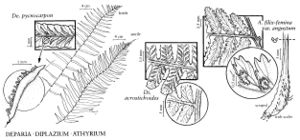Diplazium
J. Bot. (Schrader) 1800(2): 4, 61. 1801.
| Taxon | Illustrator ⠉ | |
|---|---|---|
 | Athyrium filix-femina var. angustum Deparia acrostichoides Diplazium pycnocarpon | John Myers John Myers John Myers |
Plants terrestrial or on rock. Stems creeping, ascending, or erect, stolons absent. Leaves monomorphic, evergreen or dying back in winter. Petiole ca. 1/2 to equaling length of blade, base swollen and persisting as trophopod over winter or not; vascular-bundles 2, lateral, lunate in cross-section. Blade oblong-lanceolate to deltate, 1-pinnate to 2-pinnate-pinnatifid [simple to 4-pinnate-pinnatifid], gradually reduced distally to pinnatifid apex or apical pinna similar to (conform) adjacent pinnae, herbaceous to papery. Pinnae not articulate to rachis, segment margins entire, crenulate, or serrate; proximal pinnae not reduced, sessile, equilateral or inequilateral; costae adaxially deeply grooved, grooves continuous with that of rachis; indument abaxially absent or of linear to ovate scales, adaxially absent. Veins free, simple or forked, or basal pairs of adjacent segments anastomosing. Sori single or paired back-to-back on veins, oblong to linear, straight or slightly falcate; indusia linear, laterally attached, persistent. Spores brownish, usually broadly winged. x = 40, 41.
Distribution
Worldwide
Discussion
In a few species outside the flora, rachises and costae bear multicellular hairs like those of Deparia, which differs from Diplazium in having grooves of costae not decurrent onto rachis groove, veins free or anastomosing, sori long or short and costular, and indusia present or absent. Many species of Diplazium are known to reproduce apogamously.
Species about 400 (3 in the flora).
Selected References
Key
| 1 | Leaves 2-pinnate; veins anastomosing. | Diplazium esculentum |
| 1 | Leaves 1-pinnate or 1-pinnate-pinnatifid; veins free. | > 2 |
| 2 | Scales brown, entire; pinnae nearly entire. | Diplazium pycnocarpon |
| 2 | Scales dark brown, dentate; pinnae lobed. | Diplazium lonchophyllum |
"equaling" is not a number.